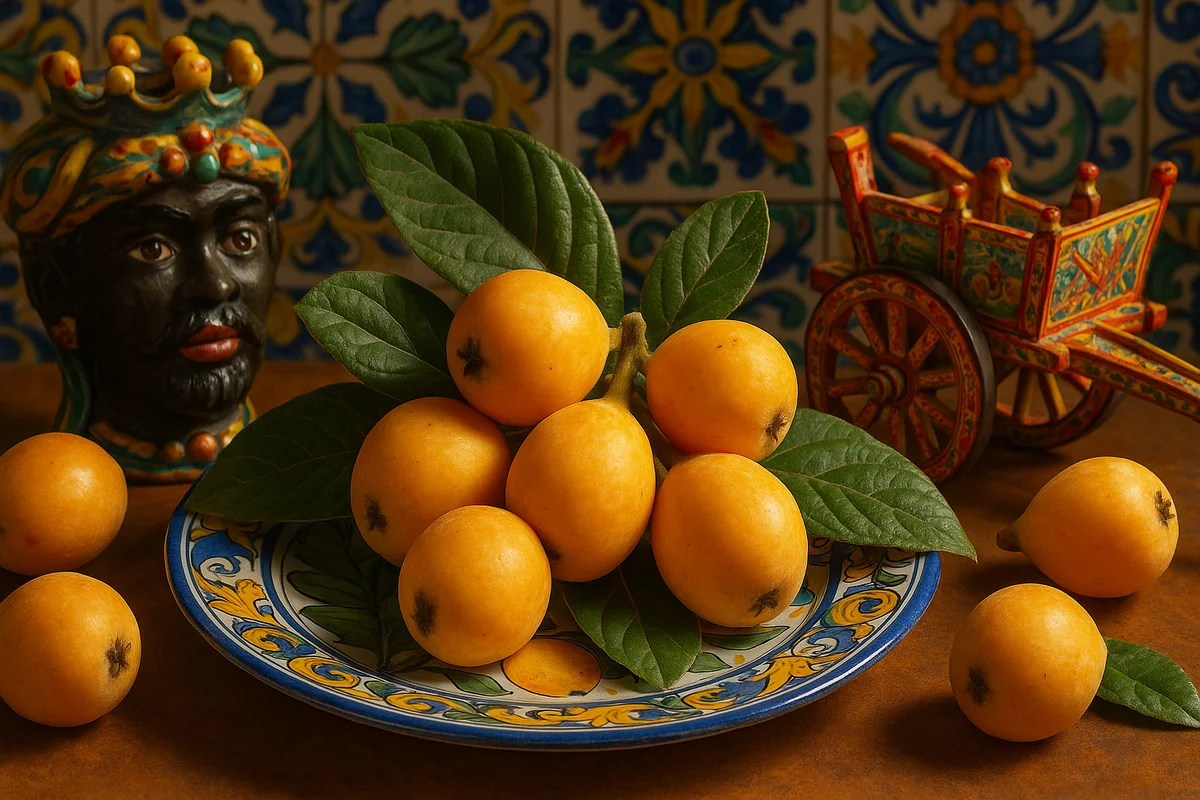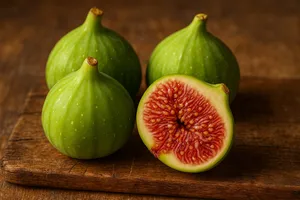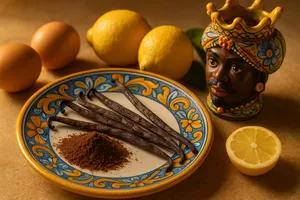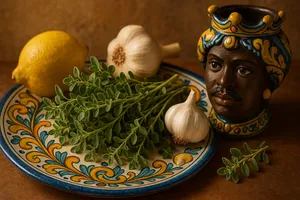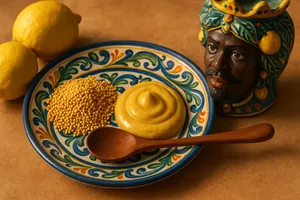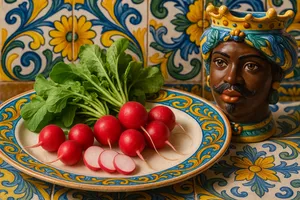Overview
The loquat, called “nèspuli” or “Japanese loquats” in Sicilian (to distinguish them from the common medlar), is the fruit of the Japanese loquat tree (Eriobotrya japonica), a species native to East Asia introduced to Europe and Sicily in the nineteenth century. These oval or rounded fruits, yellow-orange in colour with sweet, juicy and fragrant flesh, are among the earliest fruits of the Sicilian spring, ripening between April and June, when most summer fruit is not yet available, making them particularly awaited and appreciated.
In Sicily, the Japanese loquat has adapted perfectly to the mild climate, spreading rapidly through gardens, orchards and small farms. Every traditional family had a loquat tree which, besides providing delicious fruit, offered dense shade and evergreen ornamental foliage. Fresh loquats were a favourite snack for children, who often climbed the trees to pick them straight from the branches. Alongside fresh consumption, Sicilian loquats are used to make fragrant jams, syrups, liqueurs and, more rarely, desserts. Their short season makes them especially precious, a fruit to be enjoyed fully during the few weeks they are available.
Characteristics
The loquat is oval, pear-shaped or rounded, measuring 3–5 centimetres in length. The skin is thin, smooth or slightly fuzzy, yellow-orange when ripe, sometimes with reddish tinges. It peels easily.
The flesh is yellow-orange, juicy, soft and melting when fully ripe, with a texture similar to apricot but more delicate. At the centre are 2–5 large, glossy brown seeds, inedible, occupying much of the fruit’s volume.
The flavour is sweet with a slightly acidic note, very pleasant and refreshing. The aroma is delicate, fruity and characteristic. Unripe loquats are astringent and acidic, so they should be harvested and eaten only when completely ripe.
High-quality loquats have an intense, even yellow-orange skin (not green or pale, signs of immaturity), a yielding but not mushy consistency, a pleasant fragrance and no bruises or dark spots.
Japanese loquat vs common medlar
It is important to distinguish between two completely different fruits:
Japanese loquat (Eriobotrya japonica): The type most widespread in Sicily, described in this article. It ripens in spring (April–June), is yellow-orange, sweet and juicy, and eaten fresh without bletting. The tree is evergreen with large leathery leaves.
Common or German medlar (Mespilus germanica): A completely different fruit, flattened and brown, ripening in autumn and requiring a process of bletting (over-ripening) before becoming edible. It is less common in Sicily. It has a peculiar, almost fermented flavour and a pasty texture.
In Sicily, when “nespole” are mentioned without further specification, people almost always refer to Japanese loquats, while common medlars are called “true medlars” or “ancient medlars” and are now rare.
Varieties
There are several varieties of Japanese loquat, differing in size, shape, colour, flavour and ripening period.
White-fleshed varieties
These have paler flesh, a pale yellow colour, a very sweet and delicate flavour and light yellow skin. They are considered among the finest for fresh eating. They typically ripen from April to May.
Orange-fleshed varieties
These have deeper orange flesh, a slightly more acidic and aromatic flavour and yellow-orange skin. They are excellent fresh and for preserves. They ripen from May to June.
Early loquats
Varieties that ripen as early as March–April, eagerly awaited as some of the first fruit of the season. They may be smaller but are equally tasty.
Late loquats
Varieties that ripen in June, extending the season. They are often larger and sweeter.
In Sicily, many trees belong to local, unidentified varieties, handed down through generations by grafting and cuttings, each with unique characteristics known only to their owners.
Cultivation in Sicily
The Japanese loquat has become fully naturalised in Sicily, where it grows easily in open ground. It prefers a mild climate, sunny or lightly shaded positions and well-drained soil, though it is not particularly demanding. It is a hardy tree requiring little maintenance.
It reaches 4–6 metres in height and has a dense crown with large, dark green leathery leaves that remain evergreen, giving significant ornamental value. Flowering occurs in autumn and winter (October–January), producing highly fragrant white flowers in clusters. Fruits form during the winter and ripen in spring.
Trees begin to produce fruit 3–4 years after planting and can live and bear fruit for decades. A mature tree can yield abundantly, producing dozens of kilograms of fruit. In Sicily, the loquat is grown mainly in family gardens, small orchards and small plots, and only rarely in intensive cultivation.
Harvesting is done by hand. Loquats detach with a slight twisting motion, complete with their stem. They do not ripen after picking, so they must be harvested at the right stage, when they have developed their characteristic yellow-orange colour and yield slightly to pressure.
Seasonality
In Sicily, the loquat ripens from April to June, with peak production in May. The season is relatively short, around 6–8 weeks, during which trees produce abundantly. It is among the first fruits of the warm season, preceding cherries, apricots and peaches.
Ripening is staggered: the same tree bears fruit at different stages, allowing successive harvests over several weeks. Early loquats anticipate the season and late ones extend it, but in any case availability is concentrated in spring.
Culinary uses
The loquat has various uses, though fresh consumption remains the most common and appreciated.
Fresh consumption
The traditional way. Loquats peel easily by hand or with a small knife; the fruit is opened, seeds removed, and the juicy flesh enjoyed as is. They are excellent fresh, at room temperature or slightly chilled. Refreshing and thirst-quenching, they are ideal as a snack or light dessert.
Loquat jam
Loquat jam has a golden orange colour, sweet fragrant flavour and soft texture. It is wonderful for breakfast or for filling tarts and cakes. Preparation involves peeling the loquats and removing the seeds, then cooking the pulp with sugar and lemon.
Loquat syrup
From the juice of cooked loquats mixed with sugar comes an aromatic syrup used for drinks, granitas or moistening cakes. It has a golden colour and delicate aroma.
Loquat liqueur
A homemade preparation in which ripe loquats are macerated in alcohol with sugar, creating a sweet, fragrant liqueur. It is an aromatic digestif appreciated in rural Sicilian areas.
Loquats in syrup
Loquats can be preserved in syrup: peeled, seeded, briefly cooked and stored in jars with sugar syrup. They keep for months and can be used in desserts or eaten as a sweet treat.
Tarts and cakes
Fresh loquats or loquat jam enrich tarts, cakes and loaf cakes. Their sweetness and vivid colour make them delightful ingredients in homemade baking.
Fruit salads
Chopped loquats brighten spring fruit salads, pairing well with strawberries, cherries and kiwi.
Preparation
Loquats should be washed under running water before eating. For fresh consumption, they peel easily with fingers or a small knife, like apricots. The fruit is opened and the large seeds removed. The flesh is eaten as is or cut into pieces.
For cooked preparations (jams, syrups), loquats should be peeled, halved and the seeds removed. The flesh is used whole or cut into pieces. The seeds should never be eaten because they contain toxic substances (as do the seeds of many fruits in the Rosaceae family).
Peeled loquats oxidise quickly, turning brown. If not used immediately, they should be immersed in water acidulated with lemon. For jams, immediate cooking prevents oxidation.
Storage
Ripe loquats are delicate and keep in the refrigerator for 3–5 days, arranged carefully in a ventilated container or covered with paper. They should not be piled up as they bruise easily. At room temperature they last 1–2 days.
Loquats do not ripen after picking, so unripe ones will remain unripe. It is important to harvest or buy them at the right stage of ripeness.
Fresh loquats do not freeze well for fresh consumption as they lose their texture. They can be frozen as purée or in pieces for culinary use. They keep better when transformed into jam or preserved in syrup.
Tips for buying
Loquats are rarely found in supermarkets due to their delicacy and short season. They are more easily found in local markets, from specialised fruit sellers, or directly from growers.
When buying, choose fruits with an intense, even yellow-orange colour (not green or pale), with intact skin free of bruises or dark spots. They should yield slightly to pressure but not be mushy. The aroma should be pleasant and fruity.
Avoid loquats that are green (unripe), bruised, with wrinkled skin (old), or with dark spots and soft patches (spoiled). Consume them within a few days of purchase.
The best way to enjoy fresh, high-quality loquats is to pick them from your own tree or a friend’s. The difference between just-picked loquats and those bought after several days is remarkable.
Nutritional properties
Loquats are relatively low in calories: 100 grams provide about 45–50 calories. They are composed of around 85% water and contain about 12 grams of carbohydrates per 100 grams, mainly simple sugars. Protein content is minimal (around 0.5 grams) and fat negligible.
They are a good source of vitamin A (beta-carotene, responsible for their orange colour), essential for vision and skin health. They contain vitamin C, potassium, fibre and small amounts of other vitamins and minerals. They have antioxidant properties thanks to carotenoids and polyphenols.
Loquats have refreshing, diuretic and mildly laxative properties due to their fibre and water content. In Sicilian folk medicine they were considered beneficial for the digestive and urinary systems. The leaves of the loquat tree were used to prepare decoctions considered useful for respiratory issues and inflammation.
The loquat in Sicilian tradition
Although not native to the island, the Japanese loquat has become fully integrated into the Sicilian landscape and culture. In many traditional gardens, the loquat tree had a place of honour for its dense shade, evergreen ornamental foliage and delicious fruit.
Children climbed loquat trees to pick the highest and ripest fruits, returning home with their hands sticky with juice. It was one of the simple joys of the Sicilian spring. Grandmothers prepared loquat jam that perfumed the whole house.
The loquat’s winter flowering, with highly fragrant white blossoms, was also appreciated by bees, which produced honey with delicate notes. The flowers bloom when few other plants are in blossom, making them valuable for beekeeping.
Curiosities
The Japanese loquat is not originally from Japan but from China, where it has been cultivated for over a thousand years. It was introduced to Japan in ancient times and from there spread around the world, hence its Western name. In China it is called “pipa” because the shape of the fruits recalls the musical instrument of the same name.
An old Sicilian saying goes: “Quannu ci su' i nespuli, arrivannu i tempi begli” (When the loquats arrive, the good times arrive), referring to spring, the end of the cold season and the arrival of fine weather symbolised by the first sweet fruits.
In Sicily there was a belief that eating many loquats could cause intestinal discomfort due to their laxative effect. In reality, eaten in moderation they do not cause problems, but excessive consumption can indeed have a laxative effect due to their fibre and water content.
The large, leathery loquat leaves were traditionally used to wrap fresh cheeses or as a base for presenting sweets. Some farmers also used them to clean and polish copperware thanks to their rough texture.
During the Second World War, when food was scarce, loquats were a precious source of free nourishment in spring. Those who had a loquat tree in their garden were fortunate: they could offer fresh fruit to children during difficult times.
Some older Sicilians recall organising “expeditions” into abandoned gardens or countryside to gather loquats from wild or unattended trees. It was an adventure combining the search for fruit with play and exploration.
In recent times, some Sicilian farms have begun intensive cultivation of selected loquat varieties, focusing on quality and the short season to create a niche product. High-quality Sicilian loquats are exported and appreciated in national and international markets.
The loquat tree’s wood, hard and compact, was once used for small woodworking tasks, tool handles and walking sticks. Ancient trees, when pruned, provided firewood that burned slowly, producing long-lasting embers.

